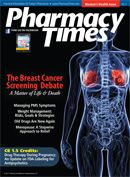Publication
Article
Pharmacy Times
Case Studies
Case One
CK is a 73-year-old man with persistent atrial fibrillation (AF), hypertension, and a family history of thyroid disease. He has been treated with dronedarone 400 mg twice daily for the past 3 months following successful electrical cardioversion. He comes to the pharmacy today to pick up a refill of dronedarone. CK tells the pharmacist, “I’ve always read about amiodarone being used for AF. My cardiologist called dronedarone a ‘sister drug’ to amiodarone.” CK is unclear about the difference between the 2 drugs and whether dronedarone is the right choice for him.
How should the pharmacist counsel CK on his prescription?
Case Two
PT is a 65-year old man with diabetes and hypertension, who is recently diagnosed with new-onset AF. PT comes to the pharmacy with a new prescription for clopidogrel 75 mg daily and instructions to purchase and take aspirin 81 mg daily. PT is well known by the pharmacist as being nonadherent with both his medications and his doctors’ visits. When dropping off his prescription, PT tells the pharmacist that he is concerned that he may not be getting the best therapy. He notes a friend of his has had AF for many years and has been taking warfarin to prevent strokes.
How should the pharmacist respond to PT?
ANSWERS
Case 1: Amiodarone is an effective antiarrhythmic for maintenance of normal sinus rhythm in AF but can cause significant adverse effects, such as pulmonary fibrosis, thyroid and hepatic dysfunction, and - others. Like amiodarone, dronedarone is a class III antiarrhythmic. It is structurally similar to amio darone (lacks an iodine moiety, but may be associated with fewer drug-related toxicities). The 2011 American College of Cardiology Foundation (ACCF)/American Heart Association (AHA)/ - Heart Rhythm Society (HRS) update of the AF guidelines recommends dronedarone as a reason able option to decrease hospitalization for cardiovascular events in patients with paroxysmal AF or after conversion of persistent AF (a class IIa/B recommendation). In 1 large randomized controlled trial, dronedarone significantly reduced the combined end point of death and cardiovascular <.001). In patients with hypertension P hospitalizations compared with placebo (31.9% vs 39.4%, without left ventricular hypertrophy (dronedarone is contraindicated in patients with class IV heart failure or patients who have had an episode of acute decompensated heart failure in the past 4 weeks, due to increased mortality in such patients), dronedarone is now preferred over amiodarone for the maintenance of sinus rhythm due to a more favorable side effect profile and decreased risk of hospitalizations. The pharmacist should counsel CK that dronedarone is an appropriate therapy for his AF and is recommended by national consensus guidelines.
Case 2: AF is the most common cardiac arrhythmia and is associated with a 5-fold increased risk of stroke. PT’s risk of stroke is “moderate,” or about 4% per year, based upon a CHADS 2 score of 2 (1 point each for diabetes and hypertension). PT is correct that warfarin is the most common agent used for stroke prevention; however, his car diologist is likely hesitant to start him on it because of his lower likelihood of adherence to warfarin and required international normalized ratio (INR) checks. According to the new 2011 ACCF/AHA/HRS AF guidelines, clopidogrel plus aspirin may be an alter native agent used in order to reduce the risk of major vascular events, including stroke, in patients - for whom oral anticoagulation therapy with warfarin is considered unsuitable due to patient pref erence or physician assessment of patient’s ability to safely sustain anticoagulation (a Class IIb/B recommendation). Of note, clinical trials suggest that the combination of clopidogrel and aspirin is less efficacious than warfarin at reducing stroke (albeit better than aspirin alone), but likely safer in patients who are unwilling or unable to adhere to warfarin therapy and required INR monitoring. Consequently, the pharmacist should feel comfortable reassuring PT that he is receiving stroke prevention therapy consistent with the national consensus guidelines.
function showAnswer() {document.getElementById("answer").style.display = 'block';document.getElementById("link").style.display = 'none';}
Dr. Coleman is associate professor of pharmacy practice and director of the pharmacoeconomics and outcomes studies group at the University of Connecticut School of Pharmacy. Mr. Straznitskas is a PharmD candidate from the University of Connecticut School of Pharmacy.







